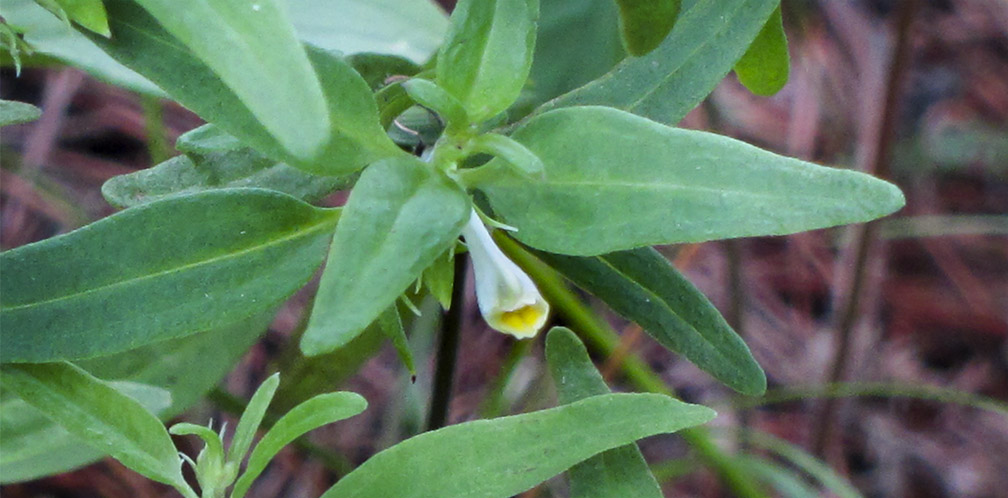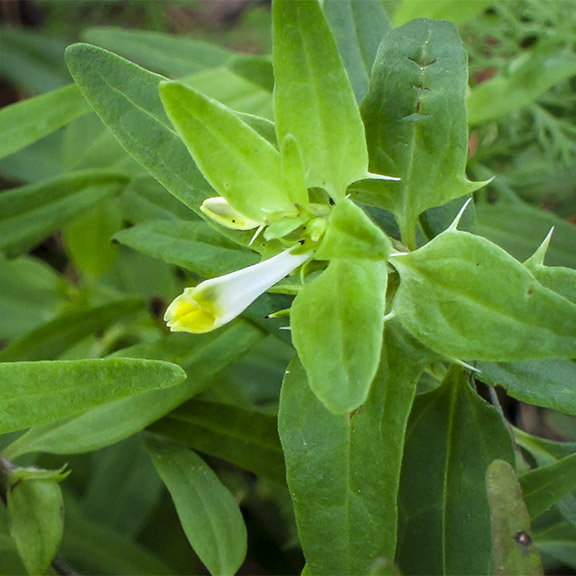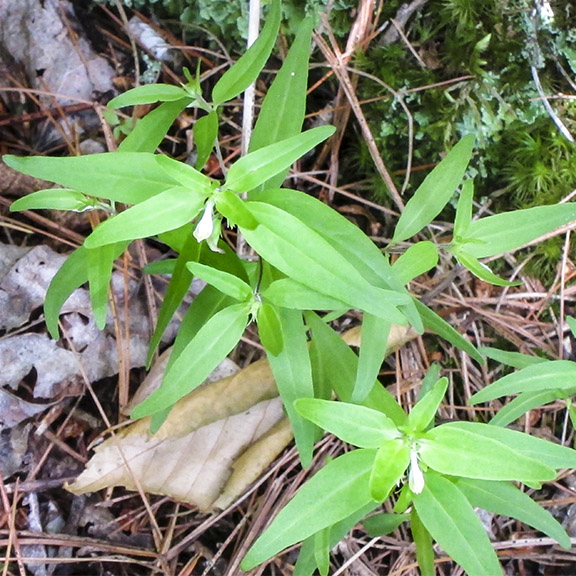Wildflowers of the Adirondacks:
Cow-wheat (Melampyrum lineare)

Cow-wheat (Melampyrum lineare) is a wildflower that produces small, tubular, white and yellow flowers. It grows on well-drained sites, often under pine trees, in the Adirondack Mountains of upstate New York State.
Other common names for Cow-wheat include Narrowleaf Cow-wheat, Narrowleaf Cowwheat, Narrow-leaved Cow-wheat, Cow Wheat, and American Cow-wheat. It is considered rare in Indiana and threatened in Ohio. The genus name (Melampyrum) is from the Greek for "black" and "wheat" and refers to the black seeds which are found in some species.
Identification of Cow-wheat

Cow-wheat usually grows 6 to 18 inches tall. It has opposite leaves, meaning that the leaves emerge from the stem in pairs. The lower leaves are lance-shaped, with smooth edges. The upper leaves may have a few pointed, triangular teeth or small lobes on each side near the base of the leaf. The leaves are 3/4 to 2.5 inches long.
Cow-wheat produces small whitish flowers with a yellow lower lip. The flowers, which are about half an inch long, are tubular. They resemble a snake's head. Cow-wheat usually blooms from early summer to early August.
Uses of Cow-wheat
There is no information on the nutritional or current medicinal uses of Cow-wheat. It is not clear whether any parts of the plant are edible. Cow-wheat does not appear to have played a major role in Native American medicine, although an infusion of the plant was reportedly used by one Indian tribe as an eye medicine.
Wildlife Value of Cow-wheat
There is no information on the wildlife value of Cow-wheat.
Distribution of Cow-wheat

Cow-wheat's range includes the eastern part of the US, south to Georgia and west to Wisconsin and Minnesota, as well as Montana, Idaho, and Washington. In Canada, it is found in the southern provinces.
In New York State, Cow-wheat is present in many counties, particularly in the eastern part of the state. This species has been documented in all counties within the Adirondack Park Blue Line, except Clinton, Lewis, Herkimer, and Fulton counties.
Habitat of Cow-wheat
Cow-wheat is moderately shade-tolerant. It prefers fairly well-drained sites. Cow-wheat is hemiparasitic, which means that it gets nourishment from both photosynthesis and root parasitism. It uses specialized root structures to take nutrients from the roots of its host. Host plants include several species of pine, poplar, and Sugar Maple. In the Adirondacks, it is often found under semi-open stands of Red Pine and Bigtooth Aspen
Cow-wheat is found in several ecological communities in the Adirondack Park:
Cow-wheat may be found along parts of many of the trails covered here, particularly those passing through a stand which includes Red Pine. Look for it growing on a bed of pine needles.
References
Michael Kudish. Adirondack Upland Flora: An Ecological Perspective (The Chauncy Press, 1992), pp. 41, 185.
New York Flora Association. New York Flora Atlas. Cow-wheat. Melampyrum lineare Desr. Retrieved 24 March 2017.
C. V. Starr Virtual Herbarium. Melampyrum lineare Desr. Retrieved 24 March 2017.
United States Department of Agriculture. The Plants Database. Narrowleaf Cowwheat. Melampyrum lineare Desr. Retrieved 24 March 2017.
Native Plant Trust. Go Botany. Cow-wheat. Melampyrum lineare. Retrieved 24 July 2021.
New York State. Department of Environmental Conservation. New York Natural Heritage Program. Ecological Communities of New York State. Second Edition (March 2014), pp. 101-102, 102-103, 108-109, 121-122. Retrieved 17 October 2015.
New York Natural Heritage Program. 2021. Online Conservation Guide for Pine-Northern Hardwood Forest. Retrieved 24 July 2021.
New York Natural Heritage Program. 2021. Online Conservation Guide for Pitch Pine-Heath Barrens. Retrieved 24 July 2021.
New York Natural Heritage Program. 2021. Online Conservation Guide for Pitch Pine-Oak-Heath Rocky Summit. Retrieved 24 July 2021.
New York Natural Heritage Program. 2021. Online Conservation Guide for Sandstone Pavement Barrens. Retrieved 24 July 2021.
New York State. Adirondack Park Agency. Preliminary List of Species Native Within the Adirondack Park Listed Alphabetically by Scientific Name and Sorted by Habit. Volume 1. Updated 10.23.2006, p. 28. Retrieved 26 January 2017.
University of Wisconsin. Flora of Wisconsin. Melampyrum lineare Desr. Retrieved 24 March 2017.
Minnesota Wildflowers. Cow Wheat (Melampyrum lineare). Retrieved 24 March 2017.
Lady Bird Johnson Wildflower Center. Melampyrum lineare. Retrieved 24 March 2017.
Lawrence Newcomb. Newcomb's Wildflower Guide (Little Brown and Company, 1977), pp. 76-77.
University of Michigan. Native American Ethnobotany. A Database of Foods, Drugs, Dyes and Fibers of Native American Peoples, Derived from Plants. Melampryum lineare Desr. Retrieved 24 March 2017.
Charles H. Peck. Plants of North Elba. (Bulletin of the New York State Museum, Volume 6, Number 28, June 1899), p. 117. Retrieved 22 February 2017.
Doug Ladd. North Woods Wildflowers (Falcon Publishing, 2001), p. 144.
Lawrence Newcomb. Newcomb's Wildflower Guide (Little Brown and Company, 1977), pp. 76-77.
Roger Tory Peterson and Margaret McKenny. A Field Guide to Wildflowers. Northeastern and North-central North America (Houghton Mifflin Company, 1968) pp. 124-125.
National Audubon Society. Field Guide to Wildflowers. Eastern Region. (Alfred A. Knopf, 2001), pp. 745-789.
William K. Chapman, et al. Wildflowers of New York in Color (Syracuse University Press, 1998), pp. 44-45.
